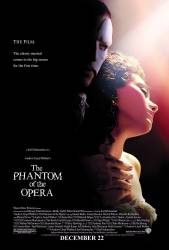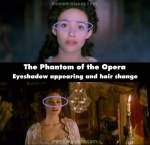Question: Why are the audience members at Don Juan shocked at the "provocative" nature of the performance? I get people were more conservative during those times, but didn't the audience members choose to go to that play? Were people just excited to see a new play and did not expect to the performance to be provocative?
Question: During "The Phantom of The Opera", when the Phantom takes Christine to his lair using the mirror passageway to his lair, it was well lit up with candles but when Meg discovers the passageway, it is dark and filled with rats. Were the candlabras just in Christine's imagination or were they real?
Answer: Almost assuredly real. The candelabras were in the Phantom's control to make appear or disappear. He brought them forward to light their entrance into the lair. However, it was generally in his best interests to keep the passageway dark and shadowy. The rats were always there, regardless. But, as rats are won't to do, scurried away from light and human movement.
Question: Why did Madame Giry silently watch the Phantom lock Christine's dressing room door?
Answer: Giry had known the Phantom since they were children, knew what his life was like then, and she has great pity for him (and great admiration, as a lover of the arts herself.) She deliberately distances herself from his wrong doings until Raul convinces her to speak up. She also understood the Phantom didn't intend to harm Christine.
Question: Why did Christine sing the first verse of the Phantom of the Opera on her way to her father's grave?
Question: If the Phantom wanted to remain in the shadows, why did he put himself in his role in Don Juan that had him basically come out in the open in front of the public eye, where everyone, especially law enforcement, could see him?
Answer: He wanted to let Christine know that he was her Don Juan. He loved her and was willing to risk everything to be the only man in her life.
Question: During the "Angel of Music" scene, Christine sees the Phantom in the mirror. is the mirror a two way, and the Phantom is on the other side, watching her? or is it a hallucination? As well (related) the room that Christine is staying in after singing "Think of Me", is that her permanent room? Or is her bedroom the one in the cellar-type with wire beds? And the big, flower one is switched out for the lead? If it is her permanent room, the phantom has some explaining to do.
Answer: Erik can see her but she can't see him because usually it's not illuminated on the Phantom's side of the mirror. Christine is standing in the 'star's' dressing room which was Carlotta's up until Christine sang Think of Me-then she was considered the star of that particular show. (There's a poster on the wall that says Carlotta on it).
Answer: Yes, it is a two-way mirror. Usually when the backs side of a two-way mirror (where The Phantom is) is dark absolutely nothing is visible other than the reflection but when you illuminate the back side, some of it is visible-like the Phantom is but not the rest of his background.
Question: Who is the little person / dwarf who follows Piangi around? (00:08:55)
Answer: He is a person born with dwarfism and is following Piangi as a side of comic relief for the audience and he is as a sort of circus act.
Question: How is the phantom still alive when Christine dies? In the movie he is about 15-20 years older than Christine.
Answer: According to Christine's tombstone, she was about 63-years-old when she died. The Phantom could still be alive, though he would probably be in his late 70s or early 80s.
Question: When exactly did the Phantom start teaching Christine?
Answer: Christine was extremely close to her father, who spoke to her of an "Angel of Music" whom he would send from heaven after his death. Christine entered the Paris Conservatoire and trained for four years to become an opera singer to please her father. However, by the end of the four years, she had lost her passion for singing and the music. When Christine arrives at the Opéra Garnier, she was described as "sounding like a rusty hinge." That is when Erik, the Phantom of the Opera, began to speak to Christine during times that she went, alone, to the chapel in the Opera House. Erik began to tutor her, telling her that he is the "Angel of Music" of whom her father had spoken.
Question: Why does Christine sing "in sleep he sang to me..." on her way to the cemetery?
Answer: She sings this on the way to the cemetery because she is thinking of the effect the Phantom has on her. This deeply troubles her as he suddenly went from a paternal figure/angel to just a man who harbors obsessive and lust-filled emotions which frightened her (as did his temper). As a child, the Phantom would sing Christine to sleep which gave her comfort she held on to. By singing this line, it shows how Christine still holds on to that comfort he provided her with and allowed him to get into her head. This emphasizes the powerful psychological hold the Phantom has over Christine. It would explain why she was still so easily drawn to him during the masquerade and wandering child scene, and was still attached to the comfort of his music. Even after all she saw him do, she still felt haunted by him.
Question: Towards the end of the movie, after he kidnaps her a second time, Christine originally has on her outfit from Don Juan but then has time to change into the white wedding dress. Why did she change? Did he make her change into that? I understand from like a movie point of view that it's a different song/act.
Answer: The Phantom forced her to change into the wedding dress shortly after he kidnapped her the second time. He intended to make Christine his "bride."







Answer: I do not think that the audience was shocked by the 'provocative' performance but the music being played. (I think that because of the conductor's reaction and whatever) But I do have an answer for as to why the audience reacted in a certain way.I suppose they are used to the kind of music that the Opera performed. I think that The Phantom purposely wrote the music in with that specific vibe and whatnot and it might be because he wanted Christine (and perhaps himself as well) to be the only performers with beautiful lyrics and music.
debbi.ee